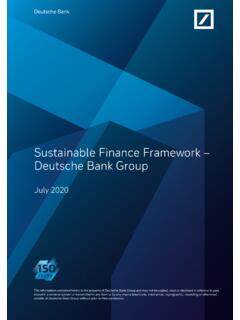Transcription of Solar - Deutsche Bank
1 Deutsche bank Markets Research Industry Solar Date 27 February 2015 North America United States Industrials Clean Technology for investors Crossing the Chasm Solar Grid Parity in a Low Oil Price Era Despite the recent drop in oil price, we expect Solar electricity to become competitive with retail electricity in an increasing number of markets globally due to declining Solar panel costs as well as improving financing and customer acquisition costs. Unsubsidized rooftop Solar electricity costs between $ $ , 30-40% below retail price of electricity in many markets globally. In markets heavily dependent on coal for electricity generation, the ratio of coal based wholesale electricity to Solar electricity cost was 7:1 four years ago. This ratio is now less than 2:1 and could likely approach 1:1 over the next 12-18 months.
2 Vishal Shah Research Analyst (+1) 212 250-0028 Jerimiah Booream-Phelps Research Associate (+1) 212 250-3037 _____ Deutsche bank Securities Inc. Deutsche bank does and seeks to do business with companies covered in its research reports. Thus, investors should be aware that the firm may have a conflict of interest that could affect the objectivity of this report. Investors should consider this report as only a single factor in making their investment decision. DISCLOSURES AND ANALYST CERTIFICATIONS ARE LOCATED IN APPENDIX 1. MCI (P) 148/04/2014. Deutsche bank Markets Research North America United States Industrials Clean Technology Industry Solar Date 27 February 2015 FITT Research Crossing the Chasm Solar Grid Parity in a Low Oil Price Era _____ Deutsche bank Securities Inc.
3 Deutsche bank does and seeks to do business with companies covered in its research reports. Thus, investors should be aware that the firm may have a conflict of interest that could affect the objectivity of this report. Investors should consider this report as only a single factor in making their investment decision. DISCLOSURES AND ANALYST CERTIFICATIONS ARE LOCATED IN APPENDIX 1. MCI (P) 148/04/2014. Vishal Shah Research Analyst (+1) 212 250-0028 Jerimiah Booream-Phelps Research Associate (+1) 212 250-3037 Despite the recent drop in oil price, we expect Solar electricity to become competitive with retail electricity in an increasing number of markets globally due to declining Solar panel costs as well as improving financing and customer acquisition costs.
4 Unsubsidized rooftop Solar electricity costs between $ $ , 30-40% below retail price of electricity in many markets globally. In markets heavily dependent on coal for electricity generation, the ratio of coal based wholesale electricity to Solar electricity cost was 7:1 four years ago. This ratio is now less than 2:1 and could likely approach 1:1 over the next 12-18 months. Electricity Prices are Increasing, Despite Nat Gas Price Swings Peak to trough, average monthly natural gas prices have decreased ~86% over the past 10 years. Yet, during this time period, average electricity prices have increased by ~20% in the US. The main driver for rising electricity bill is that T&D investments which represent 50% of bill have continued to ramp and have accelerated recently.
5 In 2010, T&D capex levels of for US Utilities ~$27B were ~300% higher than 1981 levels. We expect electricity prices worldwide to double over the next 10-15 years making the case for Solar grid parity even stronger. Solar System Costs Could Continue to Decline The economics of Solar have improved significantly due to the reduction in Solar panel costs, financing costs and balance of system costs. Overall Solar system costs have declined at ~15% CAGR over the past 8 years and we expect another 40% cost reduction over the next 4-5 years. YieldCos have been a big driver in reducing the cost of capital and we expect emergence of international yieldcos to act as a significant catalyst in lowering the cost of Solar power in emerging markets such as india .
6 How to Make Hay While the Sun Shines? The Solar sector has been generally under owned by institutional investors and we expect greater institutional ownership to drive positive momentum for the sector over the next 12-18 months. We expect a number of new business models focused on the downstream part of the value chain to emerge and expect innovative private companies to drive cost improvement/ Solar adoption. We believe companies involved in financing/downstream part of the value chain stand to generate the most significant shareholder value in the near term. Our top picks include SUNE, SCTY, SPWR, TSL, FSLR and VSLR. 27 February 2015 Clean Technology Solar Page 2 Deutsche bank Securities Inc. Table Of Contents The New Dawn .. 4 Solar Total Addressable Market is Massive.
7 6 Grid Parity is Here .. 9 Over 50% of Countries Under Review are Likely at Grid Parity Today .. 9 Electricity: Capacity and Demand Increasing .. 13 Electricity Demand Growth Will Continue to Rise .. 13 Solar Can Still Grow in Low Oil Price Era: .. 22 Worldwide Oil Use in Electricity Generation .. 22 Cost of Oil Based Electricity Generation? .. 23 Long Term Relationship between Oil and Electricity .. 25 What Makes an Electricity Bill? .. 27 Forget Oil, Even Nat Gas Has Limited Impact on Retail Electricity Prices .. 29 T&D Capex is a Significant Driver of End-User Electricity Bills .. 30 Electricity Prices Are Increasing .. 31 Solar System Costs Could Continue to Decline .. 34 Where Are We Today: Our Take .. 34 YieldCos: Enabling The Transition To Grid Parity Growth . 42 What are the benefits of YieldCos to the parent companies?
8 42 How Does a Yieldco Parentco Create Value? .. 43 Storage: The Missing Link of Solar Adoption .. 44 How To Make Hay While the Sun Shines? .. 57 Long Term Risk: Evolving Utility Business Models .. 58 Key Solar Markets Multi GW .. 59 USA .. 59 Five Reasons Why Growth in the Solar Market Could Exceed Expectations .. 59 2016, 2017 and Beyond: Our Outlook .. 76 2016 Scenario: 47 States at Grid Parity .. 78 2017+: 41 States at Grid Parity .. 80 China .. 83 Japan .. 91 india .. 98 Germany .. 107 UK .. 113 Key Markets The ~1GW Club .. 118 Mexico .. 118 Philippines .. 121 France .. 125 Chile .. 130 South Africa .. 136 Australia .. 139 Key Markets: ~500MW Club .. 144 Brazil .. 144 Canada .. 148 Thailand .. 154 Saudi Arabia .. 159 27 February 2015 Clean Technology Solar Deutsche bank Securities Inc.
9 Page 3 Table Of Contents (Cont'd)) Key Markets: <500MW .. 163 Italy .. 163 UAE .. 167 Jordan .. 170 Demand Overview .. 174 Supply .. 176 Supply .. 178 Supply Demand: Could Be Tight .. 179 27 February 2015 Clean Technology Solar Page 4 Deutsche bank Securities Inc. The New Dawn We write this report because we think Solar has now become an investable sector and over the next 5-10 years, we expect new business models to generate a significant amount of economic and shareholder value. Looking back 8-10 years ago, the Solar industry was in the primitive stages and mostly dependant on government subsidies. Most companies that came to the public market were manufacturing businesses earning above-average returns due to unsustainable government subsidies. The global financial crisis which resulted in the demise of several Solar companies was really a blessing in disguise.
10 The financial crisis really acted as a catalyst that resulted in reduction of Solar hardware costs. Emergence of innovative financing models by companies such as SolarCity and NRG really acted as the second catalyst for further reduction in Solar financing costs. As we look out over the next 5 years, we believe the industry is set to experience the final piece of cost reduction - customer acquisition costs for distributed generation are set to decline by more than half as customer awareness increases, soft costs come down and more supportive policies are announced. While the outlook for small scale distributed Solar generation looks promising, we remain equally optimistic over the prospects of commercial and utility scale Solar markets.













